Before you move into a Dunscar Self Storage centre there are a few things you’ll need to organise. Check you have the following in place:
Insurance Cover
All of your belongings need to be insured at their replacement value whilst in storage. This insurance cover can be purchased through Dunscar Self Storage, or you can get your own. PLEASE NOTE: Home content insurance normally does NOT cover your belongings in storage.
We require copies of the insurance policy you take out for your belongings in storage.
Rental Payment
Your initial rental payment and security deposit needs to be provided by cash, credit card, debit card or cheque (4 days to clear cheques).
A Security Padlock
You are the only key holder to your space at Dunscar Self Storage, which is secured with a padlock. We have padlocks available for purchase should you need one.
Information
When you move into Dunscar Self Storage premises we will require your name, address, home and mobile telephone numbers and an email address. Two forms of identification, one being a photo ID and a utility invoice (not less than three months old) to prove your current address.
Also we require a second emergency contact number and address just in case the worst might happen. (We don’t accept credit card statements or mobile phone bills as proof of residence).
Packing
Make sure all your personal belongings are correctly packaged/protected so no damage is caused while moving your belongings. We do a full range so please check our Packaging Shop, you’ll be surprised at what different types of boxes and furniture/mattress protection we’ve got
Packing Tips
When you start loading your storage room, take a few minutes to consider the items to be packed and what is the most suitable order to pack them in is. Make sure any items you may need are stored near the front so you don’t need to empty the room to get what you need. We compiled a list of do’s and don’ts for you below to help you.
The Do’s
- Pack large items into the room first. Stack and pack beds and settees on the ends to use the full height of the room and then fill the gaps with smaller items.
- Always pack tightly to prevent movement and distribute weight as evenly as you can throughout the room.
- All small items should be packed in strong boxes, use bubble wrap, paper or loose fill ensuring you fill and seal the boxes to prevent movement of belongings.
- All kitchen domestic appliances should be clean and dry with shelves secured. Remember to leave doors slightly ajar to allow air circulation and prevent condensation.
- Use boxes that stack easily together and stack small and fragile items on top of heavier boxes to prevent crushing. (We have various boxes available – visit the Packaging Shop).
- Make sure you have labels and makers to help identify the boxes and their contents.
- Pictures, photographs and mirror should be wrapped in bubble wrap and stacked on their ends and placed between softer things like mattresses and settees.
- Furniture should be protected with either dust sheets or furniture protective covers, with polished surfaces being stacked against each other.
- Fill cupboards and wardrobe – therefore using all available space.
- Dismantled items will save you space, but keep all the fittings in one place ready for rebuild.
- Make sure everything is secure and won’t fall over.
The Don’ts
You must not store any of the following items, if unsure please ask a member of staff.
- Live animals of plants
- Petrol, diesel or any other fuel
- Flammable materials of any sort
- Toxic, polluted or contaminated goods
- Radioactive materials
- Paint
- Waste of any sort
- Illegal goods, stolen
- Cash of securities
- Food or perishable goods
- Aerosol cans, gas bottles
- Firearms, munitions, explosives, fireworks

 01204 306 231
01204 306 231













